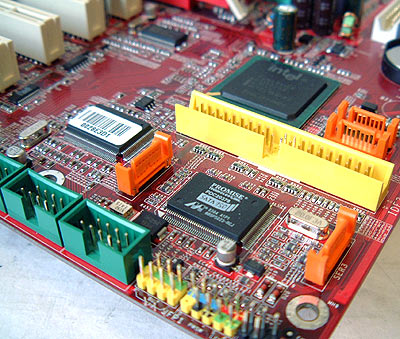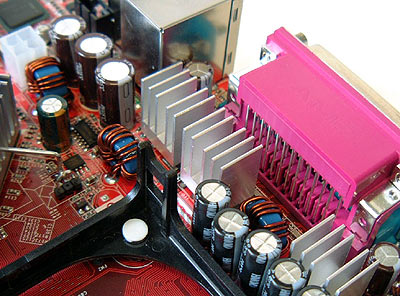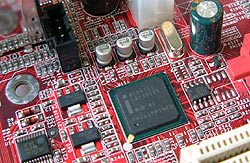With all the
header connectors located at the bottom of the motherboard, it helps to keep the
cables away from the other system devices and the clutter under
control.

If you have ever touched the MOSFET's on
a motherboard while it's operating you know well how hot they can get. It's
nice to see that MSI places passive heatsinks on top of the MOSFET's to help
keep them cool. This does wonders for peace of mind and then again
computer components can never run too cool.

While I'm not much of a case modder myself (too
lazy), those of you who enjoy modding will certainly like the LED fan on the
Northbridge. While not necessary, the i875P does generate quite a bit of heat
and active cooling is certainly a must for overclockers out there.
There are some motherboards
on the market already which rival the MSI 875P Neo-FIS2R's feature set, but many do
not include the cables or brackets to take advantage of all the devices. We're
extremely pleased to see that MSI bundles every
necessary cable or bracket to fully use all the
onboard devices with the -FIS2R model.
 I
guess the only thing the board is missing is
dual BIOS'..... that would have come in handy as I accidentally killed the original
test unit while flashing the BIOS to revision 1.3 (which is known to kill
motherboards and has since been removed from MSI's website).
I
guess the only thing the board is missing is
dual BIOS'..... that would have come in handy as I accidentally killed the original
test unit while flashing the BIOS to revision 1.3 (which is known to kill
motherboards and has since been removed from MSI's website).
With so many high speed devices on the motherboard the PCI bus could easily
become saturated, it's nice to see that MSI went with
an Intel CSA enabled Gigabit NIC. With its direct link to the Northbridge it does not
have to fight for bandwidth with the other system devices.
The 82547EI has a direct 16 bit DDR bus that
runs at 133 MHz and has a maximum bandwidth of 266MB/s, just enough
to keep a fully moving Gigabit NIC happy (Maximum bandwidth for a Gigabit NIC running full
duplex is 2Gb/s or 250 MB/s). This also free's up
the PCI bus for the other system devices. This system potentially allows for better system performance
when all the devices in the system-bus are under load.
